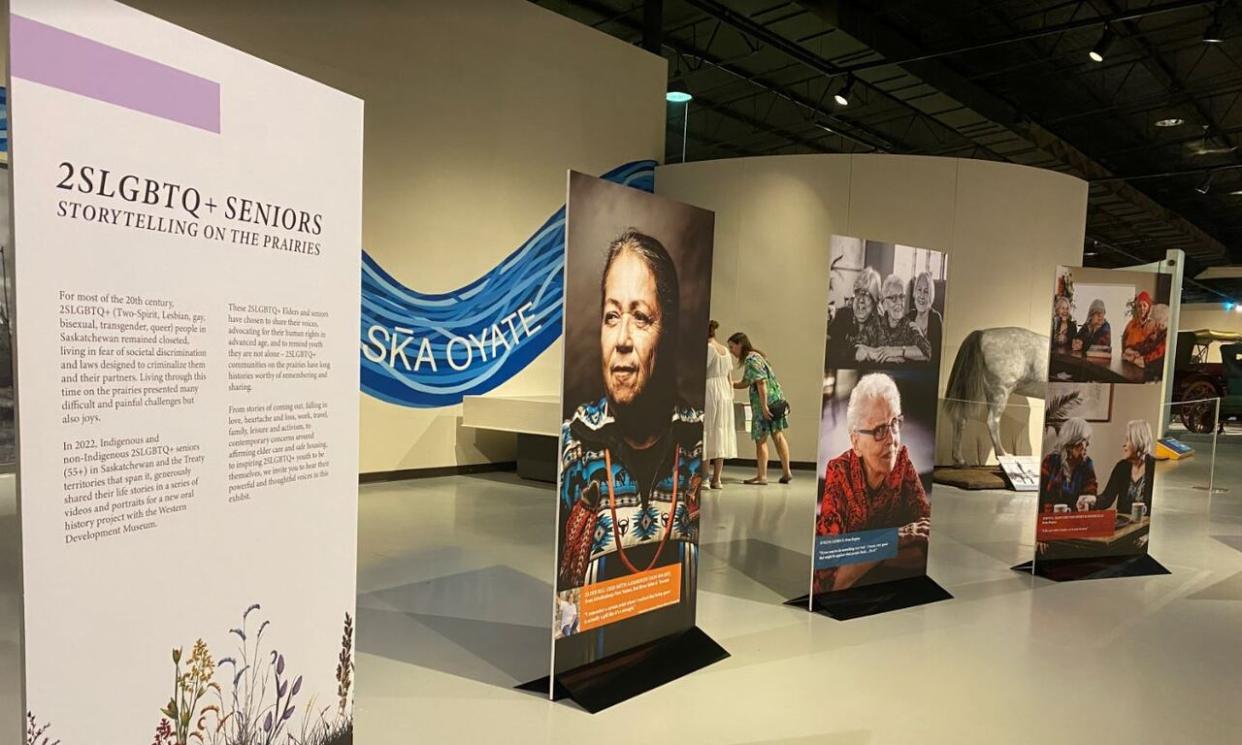Oral history project shares stories of 2SLGBTQ+ seniors in Sask.

An oral history project featuring 12 2SLGBTQ+ seniors is currently on exhibit at the Western Development Museum in Moose Jaw.
73-year-old Peter Lippmann and 63-year-old Lyle Weber met eight years ago and have now been married for five of those. The Saskatoon couple shared their stories with the museum for the project, titled 2SLGBTQ+ Seniors: Storytelling on the Prairies Portrait Exhibit.
"Throughout our history as a queer community, there's been a lot of silence. When there hasn't been silence, there's been a lot of negativity," Lippmann told CBC's Saskatchewan Weekend on Sunday.
"We just feel that part of our community's history needs to be told, spoken and recorded so that perhaps sometime in the future some of the younger community would be able to have a better understanding of what it was like for us."
Growing up, Lippmann said upon realizing his same-sex attraction, he didn't have the option to "go to the school librarian" and ask for books around this.
He came out in his mid 40s and, having been a minister in a Pentecostal group for more than two decades, he said he used to pray to "become normal".
"I was married to a woman at the time. I outed myself to her and she basically said, well, don't let the door hit your ass on the way out and [she] proceeded to call our ministerial folk and I became persona non grata very, very quickly"
Lippmann said he was not accepted within the church community and he realized that more education and visibility are needed.
For Weber, while growing up in a small town in Saskatchewan, the only "references towards gayness or homosexuality were negative." Having encountered epithets, he said he "worked really hard at repressing that sensation."
"But instead of coming out at that point, I just self-isolated for nearly 20 years and near the end of that I realized this was untenable," he said.
Weber said he was eventually fortunate to have found the OutSaskatoon centre which helped him in his journey of self-realization.
The couple said the exhibition captures moments of their joyous companionship like walking in downtown Saskatoon holding hands and people sharing positive reactions.
They said when they held their fifth wedding anniversary celebration last November, half of the guests were from their church community and the other half from the queer community.
"A couple of churches here in Saskatoon and Saskatchewan have really made inroads into inclusivity, diversity of being visible in their support of the queer community, of participating in it," Lippmann said.
The couple said they hope that younger queer members learn from the exhibit that, as a community, it's important not to give up and challenge the status quo.
"We're not going to be quiet. We're not going to disappear because you don't like us or you don't know how to handle us … I'm not going to let you beat me," Weber said, hoping the exhibit opens eyes for those outside the queer community too.
"That there's a normality to us. We're just folks. We're just people trying to live and be happy like everybody else. Our lives aren't any different than straight people, normal people, whatever they consider themselves," Lippmann said.
Stories about coming out, falling in love, heartache and loss
Alexis Jones, the programs and volunteer coordinator for Western Development Museum, said there were many hardships 2SLGBTQ+ people faced in Saskatchewan from feeling isolated and alone till lacking access to safe housing.
Jones said the exhibit invites people to learn their stories about coming out, falling in love, heartache and loss, and activism.
"Our vision is where everyone belongs in history matters. So, the museum believes that people's lives are enriched by connecting with Saskatchewan's diverse histories, and that people gain a sense of belonging and place when their histories are shared through the WDM," she said.
"We as a museum are known for collecting artifacts. But another part of a museum is collecting intangible cultural heritage, which includes knowledge and skills that are transmitted from one generation to the next."
Jones said this exhibit manifests that by collecting oral histories from seniors, including Indigenous and non-Indigenous participants.
She said WDM also aims to increase their permanent collection of the 2SLGBTQ+ history, and the museum is looking at getting clothing and accessories, event souvenirs, activism and protest materials, flags and banners, marriage and family documentation, magazines, love letters and diaries, and more stories.
"The moment of joy is seeing pictures because it's a portrait exhibit of queer people being in love and holding hands and that kind of thing and seeing the love in their eyes. I think that's really beautiful," Jones said.
"Walking through the exhibition you get to see a quote from each person and so you learn a little bit about their experience and then you get to put a face to the name and see that these are real people living in Saskatchewan."
The exhibit runs until July 14.

